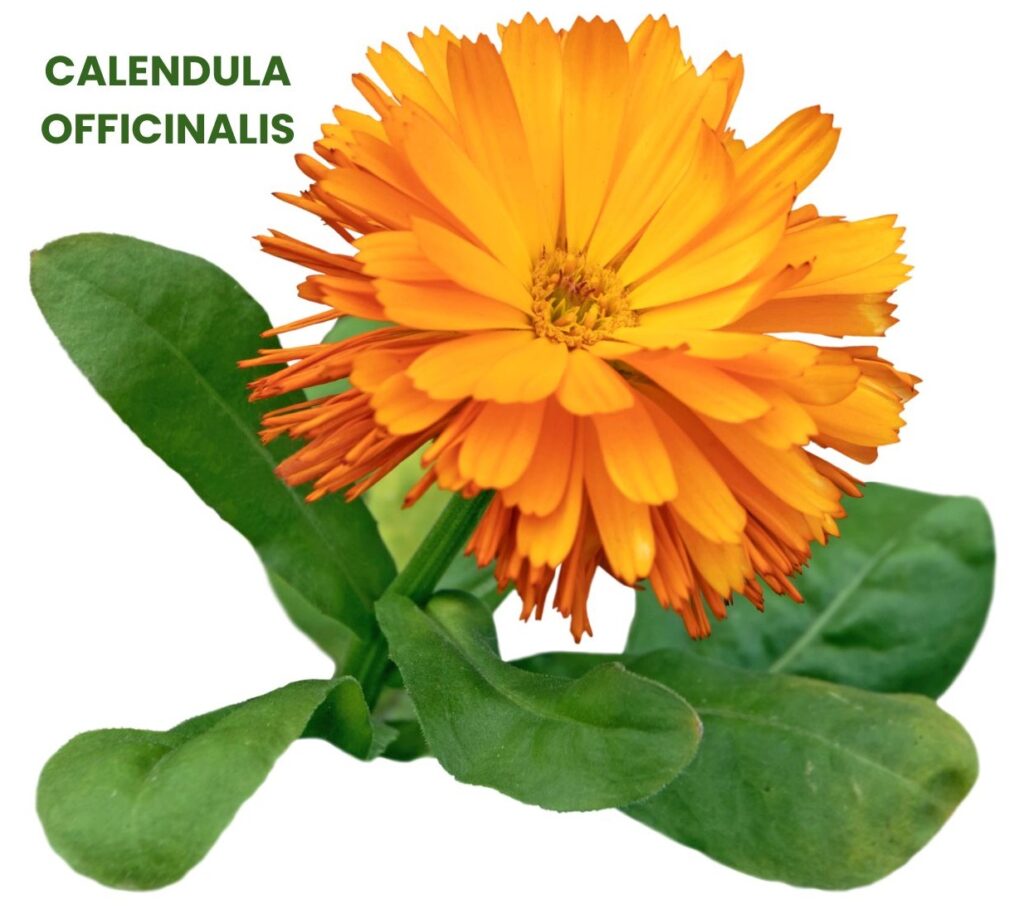Calendula Officinalis, commonly known as Marigold, is one of the most valuable remedies in homoeopathy.
Known primarily for its powerful healing properties, it is widely used to promote the repair of open wounds, ulcers, and lacerations.
Calendula helps accelerate the healing process by promoting the formation of healthy granulation tissue.
It also reduces the risk of infection and complications due to its anti-inflammatory and antiseptic qualities.

Table of Contents
ToggleSOURCE INFORMATION
Scientific Classification
- Kingdom: Plantae
- Order: Asterales
- Family: Asteraceae
- Genus: Calendula
- Species: C. officinalis
Origin
- Calendula Officinalis is native to Southern Europe, particularly in Mediterranean regions, but has since spread across temperate zones globally.
- The plant’s vibrant orange and yellow flowers have been used for centuries in traditional medicine for their healing and antiseptic properties.
Historical Use
- Historically, Calendula has been employed in folk remedies for skin ailments, such as wounds, burns, and rashes.
- It gained widespread use in homeopathy for its ability to treat wounds and promote rapid healing without infection.
- Calendula was also used during the American Civil War for treating battlefield wounds.
DRUG PATHOGENESIS
- Calendula primarily targets skin and mucous membranes.
- It has a remarkable ability to promote healing of wounds and is also helpful for catarrhal conditions and promoting healthy tissue recovery after surgery or trauma.
PHYSICAL CONSTITUTION
- Patients needing Calendula are often sensitive to external injuries or prone to wounds that heal slowly or poorly.
- They may have a tendency to catch colds easily, especially in damp or humid weather.
- This remedy is particularly beneficial for individuals with a constitutional tendency towards erysipelas or suppurative conditions.
DIATHESIS
- Calendula is indicated for individuals prone to skin infections, wounds, and ulcerations.
- These individuals often exhibit a constitutional weakness in tissue repair and may experience excessive pain or discomfort from even minor injuries.
KEY CHARACTERISTICS
- Promotes rapid healing by encouraging healthy granulation.
- Beneficial for open wounds, lacerations, burns, and ulcers.
- Reduces pain and inflammation in injuries.
- Helps with deafness worsened by damp weather.
- Tendency to develop suppurative conditions (formation of pus).
DETAILED ORGAN SYMPTOMS
HEAD
- Nervousness and an easily frightened disposition.
- Tearing headaches with a feeling of weight on the brain.
- Swollen submaxillary glands, painful to the touch.
- Effective for lacerated scalp wounds.
EYES
- Particularly beneficial in injuries to the eyes that tend to suppurate.
- Helps in post-surgical recovery.
- Treatment of blennorrhœa of the lachrymal sac (inflammation and discharge from the tear sac).
EARS
- For deafness worse in damp surroundings and eczema-like conditions of the ear.
- The patient may hear better on a train or in noisy environments but struggles with distant sounds.
NOSE
- Useful for coryza (cold), particularly affecting one nostril with green discharge.
- Symptoms include sore nostrils and chronic irritation from thick discharge.
STOMACH
- Hunger immediately after nursing or meals.
- Tendency towards bulimia, heartburn, and nausea that is felt in the chest.
- Vomiting with a sinking sensation in the stomach, often accompanied by epigastric distention.
RESPIRATORY
- Cough with green expectoration.
- Associated with hoarseness and respiratory issues accompanied by a distended inguinal ring.
- Useful for catarrhal conditions of the respiratory tract.
FEMALE REPRODUCTIVE SYSTEM
- Treats warts on the os externum (cervical opening) and menstrual suppression.
- Alleviates uterine hypertrophy, where there is a sensation of fullness and dragging in the pelvis.
- Relieves endocervicitis (inflammation of the cervical lining) and menorrhagia.
SKIN
- Promotes favorable cicatrization (scar formation) with minimal suppuration.
- Effective for superficial burns, scalds, and ulcers.
- Treats conditions like erysipelas, pustules, and wounds that are slow to heal.
FEVER
- Coldness and shuddering in the back, with skin that feels warm to the touch.
- Worse in the evening with heat and a general sensitivity to cold air.
MODALITIES
- Worse: Damp, heavy, or cloudy weather. Cold air and open wounds.
- Better: In a dry, warm environment.
WHAT ARE MODALITIES IN HOMOEOPATHY?
RELATIONSHIP WITH OTHER DRUGS
- Complementary: Hepar sulph, which assists in suppurative conditions and wound healing.
- Similar Drugs: Arnica (for bruises and trauma), Hypericum (for nerve injuries), and Hamamelis (for venous issues).
DOSAGE
- Locally: Applied topically in the form of tinctures, creams, or aqueous solutions for wounds, ulcers, and burns.
- Internally: Tincture to third potency; also used in potencies for constitutional or systemic issues.
- Burns and sores: Calendula cerate is used to treat these conditions.
Frequently Asked Questions (FAQs)
What is Calendula primarily used for?
- Calendula is mainly used for the treatment of open wounds, burns, ulcers, and slow-healing skin conditions.
- It promotes rapid healing and reduces infection risks.
Can Calendula be used internally?
- Yes, Calendula can be taken internally in the form of a tincture or in homeopathic potencies, especially for catarrhal conditions and promoting tissue healing.
What are the key characteristics of a Calendula patient?
- A sensitive, nervous, and cold patient who is prone to wounds, ulcers, and suppurative processes. They are also often worse in damp weather.
How is Calendula applied topically?
- Calendula tinctures and ointments can be applied directly to wounds, burns, and abrasions to promote healing.
Meaning of Difficult Words
- Granulation: New tissue that forms during the healing of a wound.
- Hæmostatic: A substance that helps stop bleeding.
- Suppuration: The process of forming pus.
- Blennorrhœa: Discharge of mucus, especially from the eyes.
- Epigastric: The upper central region of the abdomen.
- Inguinal: Related to the groin area.
- Cicatrization: The process of scar formation.
- Menorrhagia: Abnormally heavy or prolonged menstrual bleeding.
